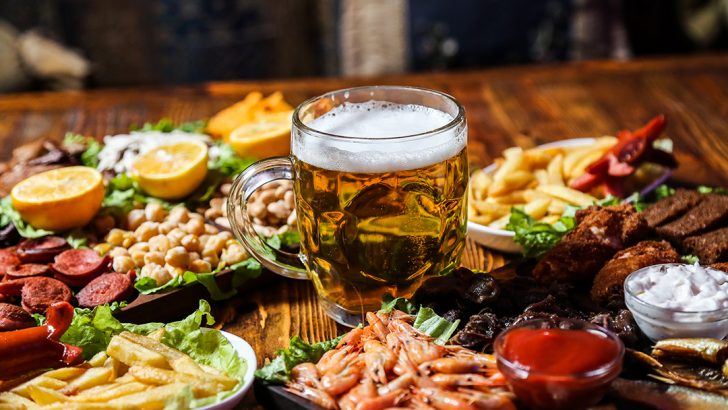While Irish cuisine can seem simple or plain, it is nothing if not hearty. Colcannon, Irish stew, chowder and potatoes of all kinds – they’re hearty, filling and rely on a limited selection of ingredients. I read recently the account a nun gave of her childhood in the West of Ireland in the early 1900s. Potatoes and fish were the staples and if the weather was bad, you had eggs instead – that was that.
Over time, these Irish dishes found a home in the pubs and carveries of Ireland, which began to reflect the best of Irish cooking. In addition, the efforts of skilful cooks and access to new ingredients has created delicious new dishes and given fresh twists to favourite classics. ‘Pub grub’ is no mean thing, and some of the finest meals can be had in Irish pubs.
As a result of Covid-19, however, these dishes can be added to a long list of good things unavailable to us. At least, not by the usual means – but we can have a go at making them ourselves! Here are just a few suggestions of dishes you can try at home to create your own carvery special.
Beef and stout stew
The perfect dish for a cold winter’s day, beef and stout stew is a staple of modern Irish cuisine. Combining two of our most famous culinary creations – stout and stew – it provides a richly textured version of the traditional Irish stew.
An added bonus are the light and fluffy suet dumplings. I remember getting stews when I was younger and picking out the dumplings to eat. With the soaked-up juices, they were a real treat. The stew recipe is fairly standard, with the addition of a pint of stout. I recommend trying Donal Skeehan’s recipe for an especially rich meal. This stew could also be used as a lovely filling for a Guinness pie!
For the dumplings, a uniquely Irish creation, here is a simple recipe:
Sift 100g self-raising flour and a little salt into a bowl. Stir in 50g of shredded suet, some parsley and then enough water to make a soft dough. Shape them into balls and add to the stew for the last 30 minutes of its cooking.
Dublin Coddle
Before we became so heavily reliant on the potato as our primary sustenance, we had a varied cuisine which included more meat and fish than 18th and 19th century Ireland. One of the dishes which was particularly popular in the 17th century was Dublin Coddle.
This dish is effectively an Irish fry turned into a casserole, combining bacon, sausage and potato in a dish which is ‘coddled’ or slow cooked. When cooked well, the juices should be fairly thick and plentiful, and the is invariably served with soda bread to mop up.
While it is traditional to simply boil the rashers and sausages, I recommend frying them lightly first. I’ve made this recipe a few times and I find frying them gives a little extra colour and seems to help the sausages to retain more flavour. It’s up to you! For a good recipe, try the The Complete Irish Pub Cookbook. I picked up a copy in a charity shop and was pleasantly surprised by the quality of the recipes.
Scrumptious sides
The first two recipes make great main courses and are sufficient in themselves. However, if you would like to add a little extra colour and flavour to your dinner, then I would recommend another Irish staple, red cabbage, with a sweet-and-sour twist. Cooked with apples and flavoured with spices, it makes a sweet, but tangy side for any dish. The best version is a German variant, which Simplyrecipes.com provide a good recipe for.
No list of Irish dishes would be complete without some sort of potato recipe. I don’t know if it’s true, but a saying was attributed to Irish emigrants to America, that “a day without potatoes is a day without nourishment”. There are plenty of dishes to choose from – boxty cakes (potato pancakes), champ and colcannon are the best known and with good reason.
Colcannon is a traditional Irish dish served often at Halloween. Some chefs will mix in lucky charms or coins, much in the fashion of barmbrack. Sufficient as a dish in its own right, it would also make a great accompaniment for the stout stew.
There are many recipes, but the basics are cabbage and mashed potato which are mixed together and either served straight away, or else baked for 30 minutes to create a potato casserole. Other ingredients can include spring onions, kale or leeks and for a richer recipe, you could add a splash of cream.
Delicious desserts
When you think of Irish desserts, you’re as likely as anything to think of apple tart or apple crumble. That at least is what it brings to my mind and when we were younger, we had it with such frequency that my sister once exclaimed “not apple tart again”! But though they are the classics, there are a number of modern Irish desserts which are worth trying out.
The first is Irish whiskey trifle, a good dish with which to warm the cockles! Trifles are said to have a stronghold in Ireland, although our modern efforts can’t match the pomp and circumstance of the 19th century English extravaganzas. Typically, Irish trifle is a combination of flan, canned fruit and jelly, combined with cream and custard and soaked in sherry.
For a spruced-up version, I recommend using macaroons, sherry and Irish Whiskey, as well as raspberry jam and homemade custard. It makes for as wholesome an experience as you can get at home, while still remaining very manageable. For this recipe, I would once again recommend the excellent The Complete Irish Pub Cookbook.
But this leads me finally to what I consider to be the pièce de resistance, the Irish Cream cheesecake. This is an unbaked cheesecake which uses no gelatine, and yet still maintains a creamy and firm consistency due to the high chocolate content. It makes use of the popular Irish Cream liqueur (such as Baileys) which lends a sharpness to an otherwise sweet dessert and adds a bit of flare.
The one thing to remember about this dessert is that it will need plenty of time to refrigerate in order to set properly. Ideally, it is best left overnight or at least cooked the morning of. I would also recommend adding more Irish Cream than most recipes advise as they are often more chocolate flavoured and less distinctive. I hope this list helps you bring some of the hearty goodness of pub-grub home!


 Ruadhán Jones
Ruadhán Jones